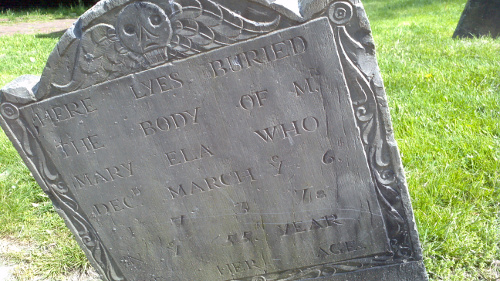Saturday 18 May 2013 — This is over 12 years old. Be careful.
I was walking through Copp’s Hill burying ground in Boston’s North End today. The gravestones are fascinating, partly for the concrete connection to a distant past, but also for their antiquated style.
For example, many of the stones had ye in place of “the.” That y isn’t actually a y, it’s a thorn, a letter that fell out of use in English a few hundred years ago. Thorn is prounounced th, so ye isn’t “yee”, it actually is “the.”
After noticing how older stones had ye and newer ones had “the”, we came across Mary Ela’s stone:
It reads:
HERE LYES BURIED
THE BODY OF Mrs.
MARY ELA WHO
DECD. MARCH Ye 6.
1 7 3 7/8
IN Ye 55. YEAR
OF HER AGE.
The odd thing here is a single gravestone that has both THE and Ye. Why use both forms? Why in one place but not the other? Perhaps because the English sentence flowed more naturally, but the dates and age felt like a conventional form?
The other transitional note is the date: 1737/8. The 7-or-8 was not because her date of death was unknown. It’s because the world didn’t agree on how to number years.
Our current calendar is the Gregorian calendar, a work of some engineering and design. Before 1752, years started on the vernal equinox, around March 21st. It wasn’t until 1752 that people agreed that the number of the year should be incremented on January 1st. In 1737, some people used year numbers incremented on January 1st, and some used years incremented in March. Since Mary Ela died in early March, some would have called the year 1737, but some would have called it 1738. Putting both numbers on the gravestone makes it clear when she died.
By the way: the year starting in March explains why September, October, November, and December are named as the 7th, 8th, 9th, and 10th months: if you count March as the first month, then the numbering makes perfect sense.
It’s fascinating to think back to those times. We deal now with confusing timezones and character sets, but at least the English alphabet and the number of the year are simple, right? Well, back in 1737, you couldn’t even count on that.

Comments
Add a comment: